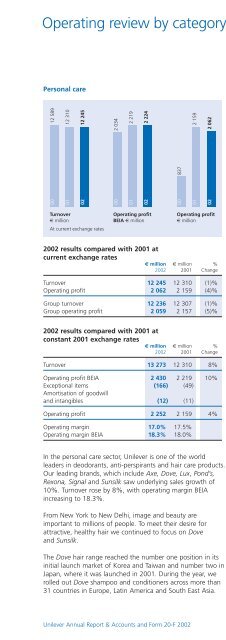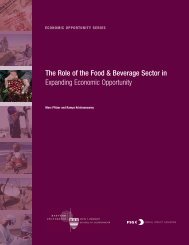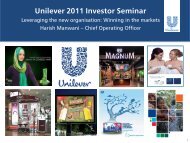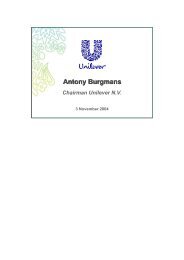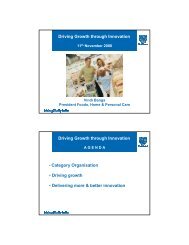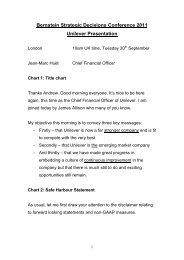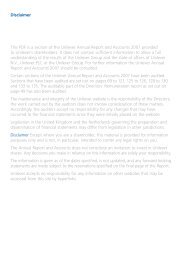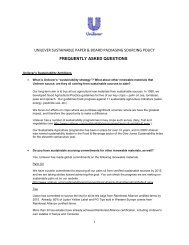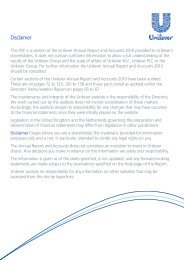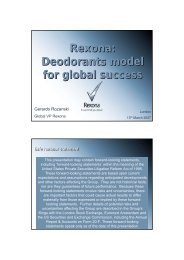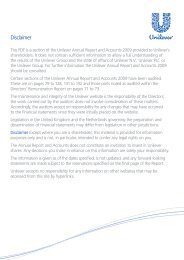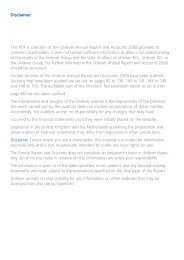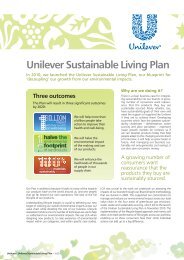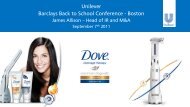Report & accounts 2002 in full - Unilever
Report & accounts 2002 in full - Unilever
Report & accounts 2002 in full - Unilever
Create successful ePaper yourself
Turn your PDF publications into a flip-book with our unique Google optimized e-Paper software.
to NV and PLC shareholders as m<strong>in</strong>ority <strong>in</strong>terests <strong>in</strong> the<br />
respective consolidated <strong>accounts</strong> of PLC and NV. This<br />
presentation would not give a true and fair view of the<br />
effect of the Equalisation Agreement, under which the<br />
position of all shareholders is as nearly as possible the<br />
same as if they held shares <strong>in</strong> a s<strong>in</strong>gle company.<br />
Net profit and result for the year reta<strong>in</strong>ed are presented on<br />
a comb<strong>in</strong>ed basis on page 69, with the net profit attributable<br />
to NV and PLC shareholders shown separately. Movements<br />
<strong>in</strong> profit reta<strong>in</strong>ed are analysed between those attributable<br />
to NV and PLC shareholders <strong>in</strong> note 22 on page 98.<br />
Foreign currencies<br />
Exchange differences aris<strong>in</strong>g <strong>in</strong> the <strong>accounts</strong> of <strong>in</strong>dividual<br />
companies are dealt with <strong>in</strong> their respective profit and loss<br />
<strong>accounts</strong>. Those aris<strong>in</strong>g on trad<strong>in</strong>g transactions are taken<br />
to operat<strong>in</strong>g profit; those aris<strong>in</strong>g on cash, current<br />
<strong>in</strong>vestments and borrow<strong>in</strong>gs are classified as <strong>in</strong>terest.<br />
In prepar<strong>in</strong>g the consolidated <strong>accounts</strong>, the profit and loss<br />
account, the cash flow statement and all other movements<br />
<strong>in</strong> assets and liabilities are translated at annual average rates<br />
of exchange. The balance sheet, other than the ord<strong>in</strong>ary<br />
share capital of NV and PLC, is translated at year-end rates<br />
of exchange. In the case of hyper-<strong>in</strong>flationary economies,<br />
the <strong>accounts</strong> are adjusted to remove the <strong>in</strong>fluences of<br />
<strong>in</strong>flation before be<strong>in</strong>g translated.<br />
The ord<strong>in</strong>ary share capital of NV and PLC is translated<br />
at the rate conta<strong>in</strong>ed <strong>in</strong> the Equalisation Agreement of<br />
£1 = Fl. 12 (equivalent to €5.445). The difference between<br />
this and the value derived by apply<strong>in</strong>g the year-end rate<br />
of exchange is taken to other reserves (see note 23 on<br />
page 98).<br />
The effects of exchange rate changes dur<strong>in</strong>g the year on<br />
net assets at the beg<strong>in</strong>n<strong>in</strong>g of the year are recorded as a<br />
movement <strong>in</strong> profit reta<strong>in</strong>ed, as is the difference between<br />
profit of the year reta<strong>in</strong>ed at average rates of exchange<br />
and at year-end rates of exchange.<br />
Goodwill and <strong>in</strong>tangible assets<br />
No value is attributed to <strong>in</strong>ternally generated <strong>in</strong>tangible<br />
assets. Goodwill (be<strong>in</strong>g the difference between the fair value<br />
of consideration paid for new <strong>in</strong>terests <strong>in</strong> group companies,<br />
jo<strong>in</strong>t ventures and associated companies and the fair value<br />
of the Group’s share of their net assets at the date of<br />
acquisition) and identifiable <strong>in</strong>tangible assets purchased after<br />
1 January 1998 are capitalised and amortised <strong>in</strong> the profit<br />
and loss account over the period of their expected useful<br />
life, up to a maximum of 20 years. Periods <strong>in</strong> excess of five<br />
years are used only where the directors are satisfied that the<br />
life of these assets will clearly exceed that period. Goodwill<br />
and <strong>in</strong>tangible assets purchased prior to 1 January 1998<br />
were written off <strong>in</strong> the year of acquisition as a movement<br />
<strong>in</strong> profits reta<strong>in</strong>ed.<br />
On disposal of a bus<strong>in</strong>ess acquired prior to 1 January 1998,<br />
purchased goodwill written off on acquisition is re<strong>in</strong>stated<br />
<strong>in</strong> arriv<strong>in</strong>g at the profit or loss on disposal.<br />
<strong>Unilever</strong> Annual <strong>Report</strong> & Accounts and Form 20-F <strong>2002</strong><br />
Account<strong>in</strong>g <strong>in</strong>formation and policies 67<br />
The treatment of goodwill and <strong>in</strong>tangibles under US GAAP is<br />
discussed on pages 118 to 120.<br />
Goodwill and <strong>in</strong>tangible assets are subject to review for<br />
impairment <strong>in</strong> accordance with United K<strong>in</strong>gdom F<strong>in</strong>ancial<br />
<strong>Report</strong><strong>in</strong>g Standard (FRS) 11 ‘Impairment of Fixed Assets and<br />
Goodwill’ and United States Statement of F<strong>in</strong>ancial<br />
Account<strong>in</strong>g Standards (SFAS) 142 ‘Goodwill and Other<br />
Intangible Assets’. Any impairment is charged to the profit<br />
and loss account as it arises.<br />
Tangible fixed assets<br />
Tangible fixed assets are stated at cost less depreciation.<br />
Depreciation is provided on a straight-l<strong>in</strong>e basis at<br />
percentages of cost based on the expected average useful<br />
lives of the assets. Estimated useful lives by major class of<br />
assets are as follows:<br />
Freehold build<strong>in</strong>gs 33-40 years<br />
(no depreciation on freehold land)<br />
Leasehold land and build<strong>in</strong>gs *33-40 years<br />
Plant and equipment 3-20 years<br />
Motor vehicles 3-6 years<br />
* or life of lease if less than 33 years<br />
Tangible fixed assets are subject to review for impairment<br />
<strong>in</strong> accordance with FRS 11 and United States SFAS 144<br />
‘Account<strong>in</strong>g for the Impairment or Disposal of Long-Lived<br />
Assets’. Any impairment is charged to the profit and loss<br />
account as it arises.<br />
Current cost <strong>in</strong>formation is given <strong>in</strong> note 10 on page 81.<br />
Fixed <strong>in</strong>vestments<br />
Jo<strong>in</strong>t ventures are undertak<strong>in</strong>gs <strong>in</strong> which the Group has<br />
a long-term participat<strong>in</strong>g <strong>in</strong>terest and which are jo<strong>in</strong>tly<br />
controlled by the Group and one or more other parties.<br />
Associated companies are undertak<strong>in</strong>gs <strong>in</strong> which the<br />
Group has a participat<strong>in</strong>g <strong>in</strong>terest and is able to exercise<br />
significant <strong>in</strong>fluence.<br />
Interests <strong>in</strong> jo<strong>in</strong>t ventures and associated companies are<br />
stated <strong>in</strong> the consolidated balance sheet at the Group’s<br />
share of their aggregate assets and liabilities.<br />
Other fixed <strong>in</strong>vestments are stated at cost less any amounts<br />
written off to reflect a permanent impairment.<br />
Current assets<br />
Stocks are valued at the lower of cost and estimated net<br />
realisable value. Cost is ma<strong>in</strong>ly average cost, and comprises<br />
direct costs and, where appropriate, a proportion of<br />
production overheads.<br />
Debtors are stated after deduct<strong>in</strong>g adequate provision for<br />
doubtful debts.<br />
Current <strong>in</strong>vestments are liquid funds temporarily <strong>in</strong>vested<br />
and are stated at their realisable value. The difference<br />
between this and their orig<strong>in</strong>al cost is taken to <strong>in</strong>terest<br />
<strong>in</strong> the profit and loss account.<br />
F<strong>in</strong>ancial Statements


